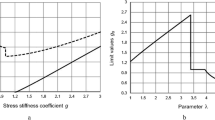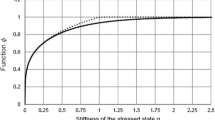The conditions that ensure the validity of nonlinear problems of elastic-plastic deformation mechanics, taking into account the growth of nucleated pore volume in the material via the Reiss–Tracey model, are investigated. Using this model, the determinants of material behavior are formulated, making it possible to describe nonisothermal processes of elastic-plastic deformation considering the increased concentration of viscous fracture pores. The loading process is broken down into separate computational stages, within which the plastic flow equation and pore concentration growth equations via the specified model are integrated over the loading stage. Through integration, the constitutive equations for the full stress and strain components are derived, allowing one to describe the active loading, unloading, and re-loading processes. The irreversible strains in these equations include accumulated plastic strains and structural bulk strains, which account for the pore concentration in the material via the Reiss–Tracey model. The solution of practical problems via the formulated equations promotes the persistence of computational processes, making it possible to use extended loading stages in calculations. At the same time, the analysis of properties of the obtained determinative equations is simplified in comparison with the equations of plasticity in finite increments. Conditions are formulated, in which the dissipation power and the power developed by additional stresses and stress-induced on additional strains do not drop during the loading of porous materials. On the basis of the obtained energy inequalities, which generalize Drucker’s postulate with respect to the porous material, conditions are established that ensure the correctness of the formulated plasticity equations, which take into account the pore volume growth via the Reiss–Tracey model.

Similar content being viewed by others
Change history
12 September 2022
A Correction to this paper has been published: https://doi.org/10.1007/s11223-022-00431-1
References
J. R. Rice and D. M. Tracey, “On the ductile enlargement of voids in triaxial stress fields”, J. Mech. Phys. Solids, 17, 201–217 (1969).
Y. Huang, “Accurate dilatation rates for spherical voids in triaxial stress fields”, J. Appl. Mech., 58, 1084–1086 (1991).
F. McClintock, “A criterion for ductile fracture by the growth of holes”, J. Appl. Mech., 35, 363–371 (1968).
J. W. Hancock and A.C. Mackenzie, “On the mechanism of ductile failure a high strength steel subjected in multi-axial stress state”, J. Mech. Phys. Solids, 24, Nos. 2–3, 147–160 (1976
P. F. Thomason, “A three-dimensional model for ductile fracture by the growth and coalescence of micro-voids”, Acta Metall. Mater., 33, 1087–1095 (1985).
A. L. Gurson, “Continuum theory of ductile rupture by void nucleation and growth: Part I. Yield criteria and flow rules for porous ductile media”, J. Eng. Mater. Tech., 99, 2–15 (1977).
V. Tvergaard and A. Needleman, “Analysis of the cup-cone fracture in a round tensile test bar”, Acta Metall. Mater., 32, 157–169 (1984).
G. R. Johnson and W. H. Cook, “Fracture characteristics of three metals subjected to various strains, strain rates, temperatures and pressures”, Eng. Fract. Mech., 21, 31–48 (1985).
Z. Chen and C. Butcher, Micromechanics Modelling of Ductile Fracture, Springer, Dordrecht–Heidelberg–New York–London (2013).
V. V. Rybin, Large Plastic Deformations and Fracture of Metals [in Russian], Metallurgy, Moscow (1986).
G. P. Karzov, B. Z. Margolin, and V. A. Shvetsova, Physical and Mechanical Modeling of Fracture Processes [in Russian], Politekhnika, St. Petersburg (1993).
V. I. Makhnenko, “Problems of examination of modern welded structures of responsible purpose”, Avtomat. Svarka, No. 5, 22–29 (2013).
L. M. Kachanov, Fundamentals of Plasticity Theory [in Russian], Nauka, Moscow (1969).
A. Yu. Chirkov, “Construction of two-level integration schemes for the equations of plasticity in the theory of deformation along the paths of small curvature”, Strength Mater., 44, No 6, 645–667 (2012), https://doi.org/10.1007/s11223-012-9420-3.
Author information
Authors and Affiliations
Corresponding author
Additional information
Translated from Problemy Mitsnosti, No. 3, pp. 5 – 17, May – June, 2022.
Rights and permissions
Springer Nature or its licensor holds exclusive rights to this article under a publishing agreement with the author(s) or other rightsholder(s); author self-archiving of the accepted manuscript version of this article is solely governed by the terms of such publishing agreement and applicable law.
About this article
Cite this article
Chirkov, O.Y. Validity Analysis of Elastic-Plastic Deformation Mechanics Problems Considering the Growth of Pores in the Material Via the Reiss–Tracey–Huang Models. Part 1. The Reiss–Tracey Model. Strength Mater 54, 345–357 (2022). https://doi.org/10.1007/s11223-022-00410-6
Received:
Published:
Issue Date:
DOI: https://doi.org/10.1007/s11223-022-00410-6




